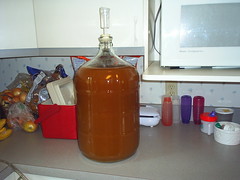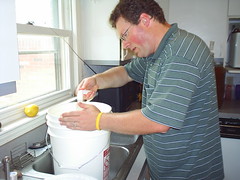Direct from Bill HD (aka (“The Beer Master”) himself:
The beer racked into the carboy:
What brewing is really all about:
(Which, btw, is why I am more or less a beer watcher rather than a beer master– ed.)
What’s a “hefeweizen?” you ask?
According to the German Beer Guide, it’s
“Hefe” means yeast, “Weizen” means wheat. Hefeweizen is a top fermented, unfiltered, bottle conditioned wheat beer with a noticeable yeast sediment and a cloudy appearance. Wheat beers are also referred to as /Weissbiers/ (white beers) because before the invention of pale lagers and pale ales, most beers were dark. Wheat beers were the exception as the wheat content lightened the colour of the beer.
Hefeweizens are usually quite sweet and fruity, with a full body. The typical hefeweizen taste, which distinguishes it from its Belgian wheat beer cousins is produced by the types of yeast used in Bavaria. There are often medicinal or clove flavours, produced by chemicals called phenols engendered by the yeast. Other chemicals produced by the yeast, called esters, produce bubble gum, banana and vanilla flavours. Esters are also used in sweets like pear drops or fruit gums. Hefeweizens are very lightly hopped so have little bitterness and harshness. The ratio of wheat to barley malt used is commonly around 50:50 but the wheat portion may rise to as much as 70%. With the exception of Gose, German wheat beer brewers don’t add coriander or other botanicals and spices to their beer as Belgian brewers do.
Bill also expressed some concern about potential contamination because of the blow-off, but I’m guessing we’ll be okay. We’ll get Bennie to taste it first just to be sure, though.


